Anne Rankine facts for kids
Quick facts for kids
Anne Rankine
|
|
|---|---|
| Born | circa 1759 Scotland
|
| Died | 1843 New Cumnock, Scotland
|
| Occupation | Housewife and Inn-keeper |
Anne Rankine was the youngest daughter of John Rankine, a farmer from Adamhill Farm in Scotland. This farm was only two miles from Lochlea, where the famous poet Robert Burns lived with his family.
On December 29, 1782, Anne married John Merry, who owned an inn in Cumnock. She is buried in the old churchyard in Cumnock. Anne believed she was the "Annie" mentioned in Robert Burns's song 'The Rigs o' Barley'. However, some people thought she might have said this to attract more customers to her inn in Cumnock. Anne's father was also related to another poet, John Lapraik.
Anne Rankine's Life
Anne was the daughter of a farmer who was a friend of Robert Burns. Burns once described her father as "rough, rude, ready-witted Rankine".
Anne married John Merry, an inn-keeper. After her husband passed away in 1802, Anne took over running the inn herself. She continued to manage the inn until she died in 1843, at the age of 84. Robert Burns even stayed at her inn in August 1786, which was four years after he wrote 'The Rigs o' Barley'.
Anne and Robert Burns
Anne Rankine always said she was the "Annie" from Burns's song 'The Rigs o' Barley'. She married in the same year the song was written. Burns sometimes walked her home from parties and gatherings in the area. It is said that the poet was very fond of her. He even gave her a lock of his hair and a tiny painting of himself. Anne kept these gifts, along with the song, for her entire life. Robert Burns himself never clearly stated who the heroine of his song was.
Robert Burns wrote "The Rigs o' Barley" early in his career. The song has a well-known chorus:
- Corn rig, an barley rigs,
- An' corn rigs are bonie, O,
- O' I'll ne'er forget that happy night,
- Amang the rigs wi' Annie, O.
The song begins with these lines:
- It was upon a Lammas night,
- When corn rigs are bonnie, O,
- Beneath the moon's unclouded light
- I held awa to Annie, O;
- The time flew by, wi' tentless heed,
- Till 'tween the late and early, O,
- Wi' sma' persuasion she agreed,
- To see me thro' the barley. O.
The song ends with these words:
- I hae been blythe wi' Comrades dear;
- I hae been merry drinking, O:
- I hae been joyfu' gath'rin gear;
- I hae been happy thinking, O:
- But a' the pleasures e'er I saw,
- Tho' three times doubl'd fairly, O,
- That happy night was worth them a' ,
- Amang the rigs o'barley, O.
It is said that Anne met the poet soon after the song was published in 1782. She told him she didn't expect to be famous in a song. Burns reportedly replied, "Oh ay, I was just wanting to give you a cast among the lave!" (meaning, "I just wanted to include you among the others!").
In 1817, someone asked Anne if she remembered nights with Burns among the "rigs o' barley." She said "No!" but then added, "I mind o' many a happy night wi' him, though." (meaning, "I remember many happy nights with him, though.")
What are 'Rigs'?
The "rigs" mentioned in the song were a traditional way of farming. Fields were divided into long, raised ridges, about three feet high. Farmers would plough these ridges from one end to the other. The furrows (ditches) created between the ridges helped drain extra water from the land, where crops like corn were planted.
See also
|


